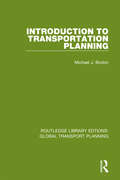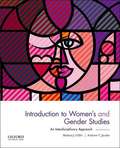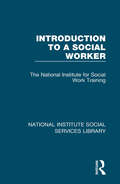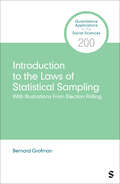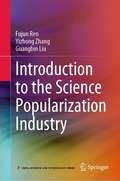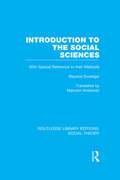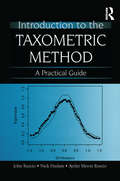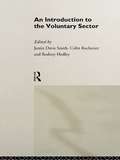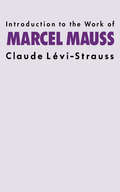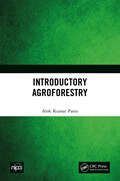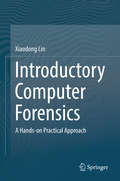- Table View
- List View
Introduction to Transportation Planning (Routledge Library Edtions: Global Transport Planning #5)
by Michael J. BrutonWhen originally published in 1975, (here re-issuing the 3rd edition of 1985), this was the only genuinely introductory textbook to the subject of transportation planning. The introductory chapter places the issue of transport in its broader societal context, relating it to demographic, socio-economic, political and environmental considerations. The increasing importance of technology is recognized in the chapter which covers commonly used software packages. As a whole the book provides a basic introduction to the traffic estimation stage of the transport planning process and forms a general guide and survey to the whole subject.
Introduction to Women's and Gender Studies: An Interdisciplinary Approach
by Melissa J. Gillis Andrew T. JacobsThis book is a truly interdisciplinary and intersectional text featuring global examples for women's, gender, and sexuality studies. Its student-centered rhetorical approach and pedagogical features―including an engaging image program, prompts for activism, a comprehensive glossary, appendices of key terms, annotated bibliographies for additional reading, and "Feminisms in Brief"―aid students in assimilating fundamental women's and gender studies terms and concepts. <P><P>While it is a textbook and not an anthology, it adopts the best facets of the anthology approach: it includes discussions of frequently anthologized writers and writing that is more engaging and narrative in style than traditional textbooks. The book systematically covers core interdisciplinary concepts so that students are prepared for women's and gender studies courses in a variety of disciplines.
Introduction to a Social Worker (National Institute Social Services Library)
by The National Institute for Social Work TrainingOriginally published in 1964, this was an introduction to social casework, that is social work with individuals and families. It was written for students at the beginning of their training and, while intended for the social worker, it would also prove useful to other students of the social sciences and interesting to the ordinary citizen who wanted to know what social work could offer either to people in trouble or to those who adopted it as a career. The book was both authoritative and up-to-date at the time, in a field in which methods of training had evolved quite rapidly. To this its origin bears witness: the preparatory work was done by Miss Florence Mitchell, an experienced social worker and teacher of social casework. The book was shaped in consultation with other practitioners and teachers, including Dr Younghusband and Miss K. M. Lewis of the National Institute whose work had done so much to shape modern methods of training. The first chapter gives a picture of people who need the social worker’s help. It is followed by a brief survey of methods, by three chapters of case studies and by a final chapter on social work in the social services. The book thus combines a philosophy with practical guidance.
Introduction to the Comparative Method With Boolean Algebra (Quantitative Applications in the Social Sciences)
by Daniele CaramaniOffering students and researchers in the behavioural and social sciences a brief and accessible introduction to the comparative method, it is ideal for students of public administration, policy, sociology, political science, social psychology, and international relations. It provides readers with basic guidelines for comparative research by addressing all key methodological issues.
Introduction to the Ethics of Emerging Technologies (Palgrave Philosophy Today)
by Mark Coeckelbergh Wessel Reijers Mark Thomas YoungIntroduction to Ethics of Emerging Technologies offers a set of lecture and seminar course materials for teaching ethics of emerging technologies. It covers the field in a comprehensive and accessible manner, emphasizing storytelling and examples, practical approaches and tools, and interactive assignments. The book addresses historical and current discourses, both academic and practical, related to the ethics of emerging technologies. This includes a basic introduction to normative ethics and applied ethics of technology, an accessible entry point to theories of technology and normativity, particular technological themes (engineering ethics, ethics of AI, and ethics of biotechnologies), as well as societal contexts in which emerging technologies play a pivotal role (citizenship, sustainability, and global inequality). This book is a must-read for science and engineering students who want to engage with the ethical impacts of their future work and research; for philosophy students who want to know more about emerging technologies; for researchers and educators interested in developing technology ethics curricula; and for general readers interested in the topic.
Introduction to the Laws of Statistical Sampling: With Illustrations From Election Polling (Quantitative Applications in the Social Sciences)
by Bernard GrofmanIntroduction to the Laws of Statistical Sampling is a clear, concept-driven guide for readers new to statistical sampling, including doctoral students and early-career researchers. Requiring only basic algebra and access to Excel, Bernard Grofman uses simulation and real-world examples—especially from election polling—to build intuition around the Central Limit Theorem and other foundational principles. Structured around six essential questions and ten "laws" of statistical sampling, the book walks readers step by step through reasoning and calculations, highlighting common pitfalls and counterintuitive results. With its accessible language, practical focus, and deep pedagogical insight, this monograph is both a primer for beginners and a valuable refresher for experienced analysts.
Introduction to the Laws of Statistical Sampling: With Illustrations From Election Polling (Quantitative Applications in the Social Sciences)
by Bernard GrofmanIntroduction to the Laws of Statistical Sampling is a clear, concept-driven guide for readers new to statistical sampling, including doctoral students and early-career researchers. Requiring only basic algebra and access to Excel, Bernard Grofman uses simulation and real-world examples—especially from election polling—to build intuition around the Central Limit Theorem and other foundational principles. Structured around six essential questions and ten "laws" of statistical sampling, the book walks readers step by step through reasoning and calculations, highlighting common pitfalls and counterintuitive results. With its accessible language, practical focus, and deep pedagogical insight, this monograph is both a primer for beginners and a valuable refresher for experienced analysts.
Introduction to the Pan-Caribbean
by Tracey SkeltonWith its diverse histories of slavery, plantations, colonialism and independence, the Caribbean is richly layered, highly complex and a wonderful example of people's resistance. The pan-Caribbean region also provides an excellent geography through which to understand and analyse the complex processes of globalisation, development, migration, tourism, and social and cultural relations. While the sea, sun and sand representation is a true one -some of the most beautiful places on earth are found in the Caribbean - the pan-Caribbean is much more intricate and fascinating than that. Where else in the world do French, Spanish, Dutch and English-speaking worlds co-exist alongside indigenous peoples and cultures? Where else have cultures of carnival, music and dance become so integrated into national and regional identities? The Caribbean is a crucible of diversity and semblance and a space that is both contradictory and harmonious.Introduction to the Pan-Caribbean has been written by people who are either from the region or have spent much of their working lives there. It is an excellent introduction and is your map through one of the most extraordinary and remarkable parts of the world.
Introduction to the Science Popularization Industry
by Fujun Ren Yizhong Zhang Guangbin LiuThis book systematically introduces the popular science industry. It firstly summarizes the social basis and research status of the development of contemporary science popularization industry and also elaborates on the basic theory and main forms of science popularization industry. The most important feature of this book is its focus on the practice and case study of the development of science popularization industry in China. Meanwhile, it analyzes the development of science popularization industry in China from four perspectives: the basis and conditions, the current situation and countermeasures, the main promotion tasks, and the policy suggestions for promotion. The book analyzes the development trend of science popularization industry in China. It can be used as a reference book for science popularization practitioners and enthusiast to learn and understand the theory and practice of science popularization industry. It can also be used as a textbook for the cultivation and training of science popularization talents.
Introduction to the Social Sciences
by John Jay BonstinglThis Introduction to the Social Sciences program is based upon the author's 17 years' experience as a social science classroom teacher at the middle school and high school levels.
Introduction to the Social Sciences (Routledge Library Editions: Social Theory)
by Maurice DuvergerProfessor Duverger at last provides the student with an overall view of the methodology of the social sciences. He briefly traces the origin of the notion of a social science, showing how it emerged from social philosophy. Its essential elements and pre-conditions are described; the splintering of social science into specialist disciplines is explained, and the need for a general sociology confirmed. The techniques of observation used by social scientists are dealt with in some detail and the unity of the social sciences is illustrated by examples of the universal application of these techniques. Documentary evidence in its various forms are described along with the basic analytical techniques, including quantitative methods and content analysis. Other methods of gathering information through polls, interviews, attitude scales and participant observation are all described. Professor Duverger brings together the different kinds of analysis used to assess the information thus gathered. Arguing that observing and theorizing are not two different stages or levels of research, he examines the practical value and difficulties of general sociological theories, partial theories and models and working hypotheses. He both describes and assesses the limitations of experiment and the scope of comparative methods in the social sciences. He then gives elementary instructions for using and assessing the value of mathematical techniques. The possibilities of presenting social phenomena through graphs and charts are also explored. There are useful book lists and diagrams.
Introduction to the Speechmaking Process (Fourteenth Edition)
by Raymond S. Ross Diana K. LeonardGood communicators are almost always knowledgeable in the critical areas of the communication process, perception, language, logical thinking, and presentation. The Speechmaking Process addresses all of these important areas and relates them eclectically to effective and responsible public speaking. The book helps students become effective critical thinkers, language users, organizers, and ethical purveyors of informative and persuasive messages.
Introduction to the Taxometric Method: A Practical Guide
by Nick Haslam John Ruscio Ayelet Meron RuscioIntroduction to the Taxometric Method is a user-friendly, practical guide to taxometric research. Drawing from both classic and contemporary research, it provides a comprehensive introduction to the method. With helpful tools and guidance, the book is intended to teach those new to the method, as well as those already familiar with it, tips on how to conduct and evaluate taxometric investigations. The book covers a broad range of analytic techniques, describing their logic and implementation as well as what is known about their performance from systematic study. The book opens with the background material essential to understanding the research problems that the taxometric method addresses. The authors then explain the data requirements of taxometric analysis, the logic of each procedure, factors that can influence results and lead to misinterpretations, suggestions for choosing the best procedures, and methodological safeguards to prevent erroneous conclusions. Illustrative examples of each procedure and consistency test demonstrate how to perform analyses and interpret results using a variety of data sets. A checklist of conceptual and methodological issues that should be addressed in any investigation is included. The downloadable resources provide a variety of programs for performing taxometric analyses along with simulations and analyses of data sets. Introduction to the Taxometric Method is ideal for researchers and students conducting or evaluating taxometric studies in the social and behavioral sciences, especially those in clinical and personality psychology, as well as those in the physical sciences, education, biology, and beyond. The book also serves as a text for courses on this method, or as a supplement in psychological assessment, statistics, or research methods courses. Familiarity with taxometrics is not assumed.
Introduction to the Voluntary Sector
by Colin Rochester Rodney Hedley Justin Davis SmithIn the 1990s the voluntary and charity sector is being forced to become an increasingly important provider of health and social welfare in Britain. How can it respond to this pressure, who is running it and how should it be managed? As well as offering a full overview of the voluntary sector the editors and contributors: examine its history and importance within welfare provision explore its current position and responsibilities offer practical guidance for and analysis of the issues facing the voluntary sector today including its legal framework in the UK and EU, fundraising management and accountability. An Introduction to the Voluntary Sector will be invaluable reading to all students and lecturers of social policy and organisational studies as well as to professional policy-makers and voluntary sector personnel.
Introduction to the Work of Marcel Mauss
by Claude Levi-StraussFirst published in 1987. Routledge is an imprint of Taylor & Francis, an informa company.
Introductory Agroforestry
by Alok Kumar PatraThe origin of agroforestry practices—growing trees and shrubs with food and fruit crops and grasses is traditional and very old—but the science of agroforestry is new. Years of experience and experiments have shown that agroforestry as a land-use system is capable of yielding both food and wood and at the same time helps in conserving and rehabilitating the ecosystems. It has the capability to increase the overall productivity of land, maintain the nutrient balance in the soil, and above all, protect the nature. In the recent years, agroforestry has been recommended as a core subject in the curriculum of B. Sc. (Forestry) and B. Sc. (Agriculture) courses of agricultural universities. This book has been divided into ten chapters covering very comprehensive information on all aspects of agroforestry including history, concepts, systems classification, tree-crop interactions, planning and management, diagnosis and design, policy and projects, and propagation and management practices of multipurpose trees. This book is co-published with NIPA. Taylor and Francis does not sell or distribute its print and electronic editions in India, Pakistan, Nepal, Bhutan, Bangladesh and Sri Lanka.
Introductory Computer Forensics: A Hands-on Practical Approach
by Xiaodong LinThis textbook provides an introduction to digital forensics, a rapidly evolving field for solving crimes. Beginning with the basic concepts of computer forensics, each of the book’s 21 chapters focuses on a particular forensic topic composed of two parts: background knowledge and hands-on experience through practice exercises. Each theoretical or background section concludes with a series of review questions, which are prepared to test students’ understanding of the materials, while the practice exercises are intended to afford students the opportunity to apply the concepts introduced in the section on background knowledge. This experience-oriented textbook is meant to assist students in gaining a better understanding of digital forensics through hands-on practice in collecting and preserving digital evidence by completing various exercises. With 20 student-directed, inquiry-based practice exercises, students will better understand digital forensic concepts and learn digital forensic investigation techniques. This textbook is intended for upper undergraduate and graduate-level students who are taking digital-forensic related courses or working in digital forensics research. It can also be used by digital forensics practitioners, IT security analysts, and security engineers working in the IT security industry, particular IT professionals responsible for digital investigation and incident handling or researchers working in these related fields as a reference book.
Introductory Criminology: The Study of Risky Situations
by Marcus Felson Mary A. EckertIntroductory Criminology: The Study of Risky Situations takes a unique and intuitive approach to teaching and learning criminology. Avoiding the fragmentation of ideas commonly found in criminology textbooks, Marcus Felson and Mary A. Eckert develop a more practical, readable structure that engages the reader and enhances their understanding of the material. Their descriptive categories, simultaneously broad and realistic, serve better than the usual philosophical categories, such as "positivism" and "classicalism," to stimulate students’ interest and critical thinking. Short chapters, each broken into 5–7 sections, describe situations in which crime is most likely to happen, and explain why they are risky and what society can and can’t do about crime. They create a framework to organize ideas and facts, and then link these categories to the leading theories developed by criminologists over the last 100 years. With this narrative to guide them, students remember the material beyond the final exam. This fresh new text was created by two professors to address the main points they encounter in teaching their own criminology courses. Problems solved include: reluctant readers, aversion to abstract thinking, fear of theory, and boredom with laundry lists of disconnected ideas. Felson, a leader in criminology theory with a global reputation for innovative thinking, and Eckert, an experienced criminal justice researcher, are uniquely qualified to reframe criminology in a unified arc. By design, they offer abstractions that are useful and not overbearing; their prose is readable, and their concepts are easy to comprehend and remember. This new textbook challenges instructors to re-engage with theory and present the essence of criminological thought for adult learners, coaching students to grasp the concept before any label is attached and allowing them to emerge with deeper understanding of what each theory means and offers. Lean, with no filler or fluff like stock photos, Introductory Criminology includes the authors’ graphics to crystallize and expand concepts from the text.
Introductory Readings In Anthropology
by Brian Street Hilary Callan Simon UnderdownAnthropology seeks to understand the roots of our common humanity, the diversity of cultures and world-views, and the organisation of social relations and practices. As a method of inquiry it embraces an enormous range of topics, and as a discipline it covers a multitude of fields and themes, as shown in this selection of original writings. As an accessible entry point, for upper-level students and first year undergraduates new to the study of anthropology, this reader also offers guidance for teachers in exploring the subject's riches with their students. That anthropology is an immensely expansive inquiry of study is demonstrated by the diversity of its topics - from nature conservation campaigns to witchcraft beliefs, from human evolution to fashion and style, and from the repatriation of indigenous human remains to research on literacy. There is no single 'story of anthropology'. Taken together, these fundamental readings are evidence of a contemporary, vibrant subject that has much to tell us about all the worlds in which we live.
Introductory Remote Sensing Principles and Concepts
by Paul Gibson With contributions from Clare PowerIntroduction to Remote Sensing: Digital Image Processing and Applications presents a unique textbook/downloadable resources package. It explains how digital images can be processed and offers practical hands-on experience of image processing. This package, which is ideal for student self-study, institutional or library purchase, shows how digital images can be processed to maximize information output and discusses a range of environmental monitoring techniques. A range of case studies are explored, drawn from a variety of disciplines and from across the world. The book also includes a practical manual of image processing instruction and detailed practical exercises to support the unique downloadable resources which accompanies the book.The downloadable resources contain fully functioning image processing software - a limited edition of DRAGON software developed specifically for readers of Introductory Remote Sensing - and over 70 satellite digital datasets for 9 scenes across America, Ireland, China, Sudan, Peru, Western Europe and the UK.
Introductory Sketch of the Bantu Languages (Routledge Revivals)
by Alice WernerFirst published in 1919, this volume provides a detailed linguistic breakdown of the Bantu language family of Central and Southern Africa. Its author held in-situ expertise in Nanja, Swahili, Zulu, Giryama and Pokomo. A professor of Swahili and Bantu languages, she was the author of several books on Bantu languages and African peoples. The volume aims to depict the broad principles underlying the structure of the Bantu language family and attempts a classification of those languages. Contemporaneous with the colonization of Tanzania, many of the areas to which this volume was relevant were under British control at the time of publication.
Introductory Spatial Analysis (Routledge Revivals)
by David UnwinFirst published in 1981, Introductory Spatial Analysis uses ideas from dimensional analysis and stochastic process theory to provide a consistent, logical framework for map analysis. ‘Geography is about maps’, so the saying goes, yet there is no other textbook for geography students that combines the discussion of maps with a treatment of quantitative methods of map analysis. This book differs from most other quantitative or cartographic geography texts in three respects: first it is a geography, not a statistics book, and therefore problems are examined by looking at the types of data used and the varieties of maps drawn and then at the analytical procedures that may be used to detect significant spatial patterns; second, no attempt is made to introduce tests that treat data without reference to their spatial location; and third, no advice is offered on specifically cartographic questions of map drawing and design.David Unwin’s text will serve as a valuable introduction to the techniques of spatial analysis that are so important in contemporary geographical study.
Introductory Statistics Using R: An Easy Approach
by Herschel KnappFinally, a textbook that makes it simple to teach and learn introductory statistics using the R software! Herschel Knapp′s Introductory Statistics Using R: An Easy Approach is a jargon-free guide to real-world statistics designed to concisely answer three important questions: Which statistic should I use? How do I run the analysis? How do I document the results? Practical examples presented throughout the text with exercises at the end of each chapter build proficiency through hands-on learning. The student website includes datasets, prepared R code for each statistic in the R Syntax Guide, and tutorial videos. As well as learning statistics, with this text students learn how to convert numeric results into clear, publishable documentation.
Introductory Statistics Using R: An Easy Approach
by Herschel KnappFinally, a textbook that makes it simple to teach and learn introductory statistics using the R software! Herschel Knapp′s Introductory Statistics Using R: An Easy Approach is a jargon-free guide to real-world statistics designed to concisely answer three important questions: Which statistic should I use? How do I run the analysis? How do I document the results? Practical examples presented throughout the text with exercises at the end of each chapter build proficiency through hands-on learning. The student website includes datasets, prepared R code for each statistic in the R Syntax Guide, and tutorial videos. As well as learning statistics, with this text students learn how to convert numeric results into clear, publishable documentation.
Intuition and Reality: A Study of the Attributes of Substance in the Absolute Idealism of Spinoza (Routledge Revivals)
by James ThomasPublished in 1999, this study focuses on the work of absolute idealist readers of Spinoza's metaphysics, such as John Clark Murray and Leslie Armour. The text is intended to establish a better absolute idealist interpretation of the identity of Spinoza's one substance (reality) with each of its diversity of "attributes". Consideration is given to the interpretations developed by these earlier commentators, who read the attributes as one metaphysical being diversely interpreted. The author finds this disadvantageous in understanding the "parallelism" of the attributes, or Spinoza's doctrine that the same order and connection of things is found in each. This problem can be solved with an alternative absolute idealist reading of the attributes as one order diversely intuited.
